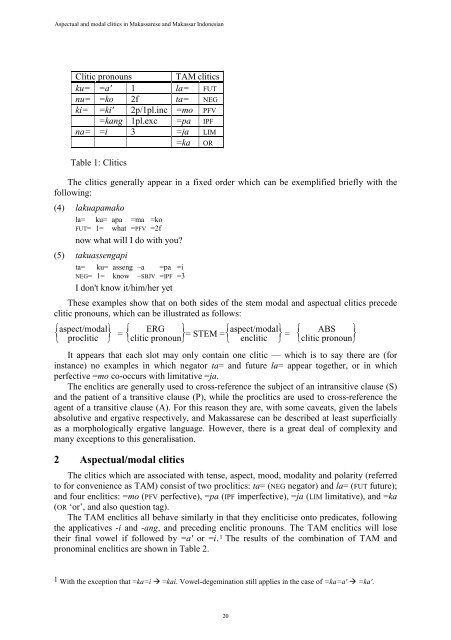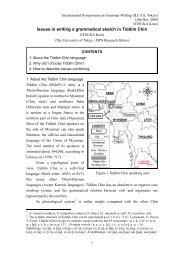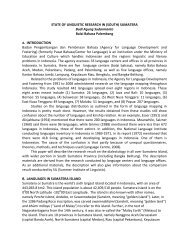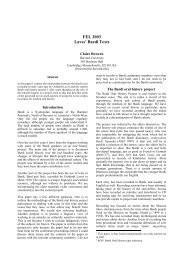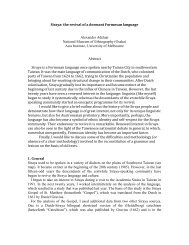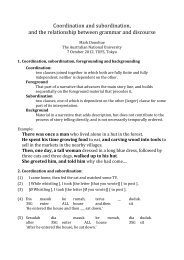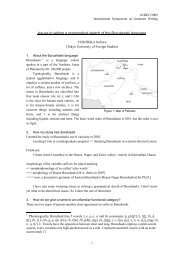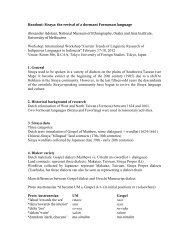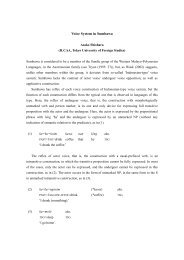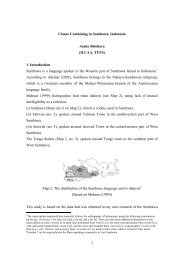Aspectual and modal clitics in Makassarese and Makassar Indonesian
Aspectual and modal clitics in Makassarese and Makassar Indonesian
Aspectual and modal clitics in Makassarese and Makassar Indonesian
Create successful ePaper yourself
Turn your PDF publications into a flip-book with our unique Google optimized e-Paper software.
<strong>Aspectual</strong> <strong>and</strong> <strong>modal</strong> <strong>clitics</strong> <strong>in</strong> <strong><strong>Makassar</strong>ese</strong> <strong>and</strong> <strong>Makassar</strong> <strong>Indonesian</strong><br />
Clitic pronouns TAM <strong>clitics</strong><br />
ku= =a' 1 la= FUT<br />
nu= =ko 2f ta= NEG<br />
ki= =ki' 2p/1pl.<strong>in</strong>c =mo PFV<br />
=kang 1pl.exc =pa IPF<br />
na= =i 3 =ja LIM<br />
=ka OR<br />
Table 1: Clitics<br />
The <strong>clitics</strong> generally appear <strong>in</strong> a fixed order which can be exemplified briefly with the<br />
follow<strong>in</strong>g:<br />
(4) lakuapamako<br />
la= ku= apa =ma =ko<br />
FUT= 1= what =PFV =2f<br />
now what will I do with you?<br />
(5) takuassengapi<br />
ta= ku= asseng –a =pa =i<br />
NEG= 1= know –SBJV =IPF =3<br />
I don't know it/him/her yet<br />
These examples show that on both sides of the stem <strong>modal</strong> <strong>and</strong> aspectual <strong>clitics</strong> precede<br />
clitic pronouns, which can be illustrated as follows:<br />
⎧ aspect/<strong>modal</strong>⎫<br />
⎨<br />
⎩ proclitic<br />
⎬<br />
⎭<br />
⎧ ERG ⎫ ⎧ aspect/<strong>modal</strong>⎫<br />
= ⎨<br />
⎩ clitic pronoun<br />
⎬ = STEM = ⎨<br />
⎭ ⎩ enclitic<br />
⎬<br />
⎭ =<br />
⎧ ABS ⎫<br />
⎨<br />
⎩ clitic pronoun<br />
⎬<br />
⎭<br />
It appears that each slot may only conta<strong>in</strong> one clitic — which is to say there are (for<br />
<strong>in</strong>stance) no examples <strong>in</strong> which negator ta= <strong>and</strong> future la= appear together, or <strong>in</strong> which<br />
perfective =mo co-occurs with limitative =ja.<br />
The en<strong>clitics</strong> are generally used to cross-reference the subject of an <strong>in</strong>transitive clause (S)<br />
<strong>and</strong> the patient of a transitive clause (P), while the pro<strong>clitics</strong> are used to cross-reference the<br />
agent of a transitive clause (A). For this reason they are, with some caveats, given the labels<br />
absolutive <strong>and</strong> ergative respectively, <strong>and</strong> <strong><strong>Makassar</strong>ese</strong> can be described at least superficially<br />
as a morphologically ergative language. However, there is a great deal of complexity <strong>and</strong><br />
many exceptions to this generalisation.<br />
2 <strong>Aspectual</strong>/<strong>modal</strong> <strong>clitics</strong><br />
The <strong>clitics</strong> which are associated with tense, aspect, mood, <strong>modal</strong>ity <strong>and</strong> polarity (referred<br />
to for convenience as TAM) consist of two pro<strong>clitics</strong>: ta= (NEG negator) <strong>and</strong> la= (FUT future);<br />
<strong>and</strong> four en<strong>clitics</strong>: =mo (PFV perfective), =pa (IPF imperfective), =ja (LIM limitative), <strong>and</strong> =ka<br />
(OR ‘or’, <strong>and</strong> also question tag).<br />
The TAM en<strong>clitics</strong> all behave similarly <strong>in</strong> that they encliticise onto predicates, follow<strong>in</strong>g<br />
the applicatives -i <strong>and</strong> -ang, <strong>and</strong> preced<strong>in</strong>g enclitic pronouns. The TAM en<strong>clitics</strong> will lose<br />
their f<strong>in</strong>al vowel if followed by =a' or =i. 1 The results of the comb<strong>in</strong>ation of TAM <strong>and</strong><br />
pronom<strong>in</strong>al en<strong>clitics</strong> are shown <strong>in</strong> Table 2.<br />
1 With the exception that =ka=i =kai. Vowel-degem<strong>in</strong>ation still applies <strong>in</strong> the case of =ka=a' =ka'.<br />
20


